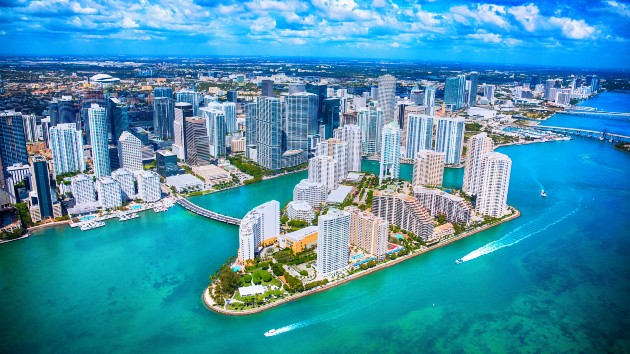Miami grapples with how to save treasured bay from rising seas, pollution

By STEPHANIE EBBS, JON SCHLOSBERG, GINGER ZEE and LINDSEY GRISWOLD, ABC News
(MIAMI) — An unprecedented fish kill in Miami’s Biscayne Bay this summer has brought a new push to address issues caused by sea level rise and pollution.
Sea-level rise in Miami and southeast Florida is not a new problem. The water in the area has risen 5 inches since 1993, and a new $400 million pump system is what is keeping a large part of the city dry.
The Miami-Dade County Water and Sewer Department is already planning for a worst-case scenario when it comes to sea-level rise.
“If you look from now till 2040 — so 20-year horizon — we’re planning on worst case about 11 inches of sea level rise, which if you live in South Florida that’s a very frightening thing in your coastal community,” Kevin Lynskey, the department’s director, told ABC News.
Biscayne Bay is described as a turquoise paradise that laps at the coast of southeast Florida and kisses the barrier island of Miami Beach. It includes a national park and aquatic preserve to protect wildlife in the area.
Rachel Silverstein, executive director of the advocacy group Miami Waterkeeper, called it one of the jewels of the state.
“Biscayne Bay generates billions of dollars annually for our regional economy,” she said.
But the bay is dying.
Canals are carrying trash, fertilizer runoff and contamination from failing septic tanks into the bay.
Over the summer, all the chemicals running into the bay — combined with record heat levels — starved the oxygen out of the water, killing thousands of fish.
“These suffocation events, and this is something that just happened recently in Biscayne Bay, just in early August … is a well-documented pattern of how water bodies essentially die, all around Florida and all around the world, so there’s a very tight connection between nutrient pollution and bacteria levels and these kinds of fish kills,” Silverstein said.
Louis Aguirre, a reporter from Miami ABC affiliate WPLG-TV, recently produced a special about the challenges facing Biscayne Bay.
“We have over 100,000 septic tanks in Miami-Dade County — still to this day. And we need to transition those septic tanks and connectors to our sewer system, which is also aging, ASAP because those septics are just spewing wastewater into our groundwater. You know Miami-Dade only stays 6 feet above sea level, so whatever goes through our groundwater goes into our bay, and that’s pretty disgusting,” he told ABC News.
In a typical septic system, waste from the house enters the tank, the solid waste settles to the bottom and the water goes to the drain field to be clarified. But when sea levels rise it interferes with that process, and the drain field mixes with groundwater and the septic tank fails.
That means waste from a toilet can go directly into the groundwater.
The Miami Dade Water and Sewer Department tells ABC News they have identified 10,000 tanks today that are not high enough anymore, and in 20 years, that number will reach 50,000.
Lynskey explained they are not just focused on septic, they’re also concerned about the canal systems keeping South Florida from turning back into a swamp. As sea levels rise, the canals pick up more trash, nitrogen and phosphorus from fertilizer used on farms and lawns and carries it right into Biscayne Bay.
But there is cause for hope.
Tampa Bay faced a similar challenge in the 1970s when the water was so covered in algae the seagrass died and fish and wildlife was driven out. After decades of effort to prevent polluted water from entering the bay, the seagrass has returned to nearly the same level as 1950, an area the size of Manhattan.
But Miami Waterkeeper said the city needs big changes in its sewage infrastructure to prevent more fish kills and preserve the bay.
“So we urgently need to be doing these investments and taking these opportunities we have to retrofit how our city is built and how it functions to be ready for sea-level rise,” Silverstein told ABC News.
The city of Miami agrees the problem is serious, but Lynskey said local leaders haven’t agreed on a path forward. The department is in the process of raising key infrastructure as high as 20 feet above sea level to reduce risk.
“Nobody’s come up with a magic bullet, we’ve already built billions of dollars of buildings and infrastructure. How do we make those survive? We’re still very much grappling with all that,” Lynskey said.
He said that as the sea level continues to rise tough decisions may have to be made from expensive septic tank replacements to decisions on whether to relocate.
“I think over the next 15 years, people are going to have to make some fundamental decisions on whether we’re going to try to keep every inch of land that humans live on, or are there some properties east of the ridge, where ultimately we retreat from and politically, I don’t think we’re there yet, but behind the scenes you can hear the conversations,” Lynskey told ABC News.
Copyright © 2020, ABC Audio. All rights reserved.
You Might Also Like



